NASA’s Webb, Hubble telescopes affirm universe’s expansion rate, puzzle persists
IMAGE:
THIS IMAGE OF NGC 5468, A GALAXY LOCATED ABOUT 130 MILLION LIGHT-YEARS FROM EARTH, COMBINES DATA FROM THE HUBBLE AND JAMES WEBB SPACE TELESCOPES. THIS IS THE FARTHEST GALAXY IN WHICH HUBBLE HAS IDENTIFIED CEPHEID VARIABLE STARS. THESE ARE IMPORTANT MILEPOST MARKERS FOR MEASURING THE EXPANSION RATE OF THE UNIVERSE. THE DISTANCE CALCULATED FROM CEPHEIDS HAS BEEN CROSS-CORRELATED WITH A TYPE IA SUPERNOVA IN THE GALAXY. TYPE IA SUPERNOVAE ARE SO BRIGHT THEY ARE USED TO MEASURE COSMIC DISTANCES FAR BEYOND THE RANGE OF THE CEPHEIDS, EXTENDING MEASUREMENTS OF THE UNIVERSE'S EXPANSION RATE DEEPER INTO SPACE.
view moreCREDIT: NASA, ESA, CSA, STSCI, ADAM G. RIESS (JHU, STSCI)
When you are trying to solve one of the biggest conundrums in cosmology, you should triple check your homework. The puzzle, called the "Hubble Tension," is that the current rate of the expansion of the universe is faster than what astronomers expect it to be, based on the universe's initial conditions and our present understanding of the universe’s evolution.
Scientists using NASA's Hubble Space Telescope and many other telescopes consistently find a number that does not match predictions based on observations from ESA's (European Space Agency's) Planck mission. Does resolving this discrepancy require new physics? Or is it a result of measurement errors between the two different methods used to determine the rate of expansion of space?
Hubble has been measuring the current rate of the universe’s expansion for 30 years, and astronomers want to eliminate any lingering doubt about its accuracy. Now, Hubble and NASA’s James Webb Space Telescope have tag-teamed to produce definitive measurements, furthering the case that something else – not measurement errors – is influencing the expansion rate.
“With measurement errors negated, what remains is the real and exciting possibility we have misunderstood the universe,” said Adam Riess, a physicist at Johns Hopkins University in Baltimore. Riess holds a Nobel Prize for co-discovering the fact that the universe’s expansion is accelerating, due to a mysterious phenomenon now called “dark energy.”
As a crosscheck, an initial Webb observation in 2023 confirmed that Hubble measurements of the expanding universe were accurate. However, hoping to relieve the Hubble Tension, some scientists speculated that unseen errors in the measurement may grow and become visible as we look deeper into the universe. In particular, stellar crowding could affect brightness measurements of more distant stars in a systematic way.
The SH0ES (Supernova H0 for the Equation of State of Dark Energy) team, led by Riess, obtained additional observations with Webb of objects that are critical cosmic milepost markers, known as Cepheid variable stars, which now can be correlated with the Hubble data.
“We’ve now spanned the whole range of what Hubble observed, and we can rule out a measurement error as the cause of the Hubble Tension with very high confidence,” Riess said.
The team’s first few Webb observations in 2023 were successful in showing Hubble was on the right track in firmly establishing the fidelity of the first rungs of the so-called cosmic distance ladder.
Astronomers use various methods to measure relative distances in the universe, depending upon the object being observed. Collectively these techniques are known as the cosmic distance ladder – each rung or measurement technique relies upon the previous step for calibration.
But some astronomers suggested that, moving outward along the “second rung,” the cosmic distance ladder might get shaky if the Cepheid measurements become less accurate with distance. Such inaccuracies could occur because the light of a Cepheid could blend with that of an adjacent star – an effect that could become more pronounced with distance as stars crowd together and become harder to distinguish from one another.
The observational challenge is that past Hubble images of these more distant Cepheid variables look more huddled and overlapping with neighboring stars at ever farther distances between us and their host galaxies, requiring careful accounting for this effect. Intervening dust further complicates the certainty of the measurements in visible light. Webb slices though the dust and naturally isolates the Cepheids from neighboring stars because its vision is sharper than Hubble’s at infrared wavelengths.
“Combining Webb and Hubble gives us the best of both worlds. We find that the Hubble measurements remain reliable as we climb farther along the cosmic distance ladder,” said Riess.
The new Webb observations include five host galaxies of eight Type Ia supernovae containing a total of 1,000 Cepheids, and reach out to the farthest galaxy where Cepheids have been well measured – NGC 5468 – at a distance of 130 million light-years. “This spans the full range where we made measurements with Hubble. So, we've gone to the end of the second rung of the cosmic distance ladder,” said co-author Gagandeep Anand of the Space Telescope Science Institute in Baltimore, which operates the Webb and Hubble telescopes for NASA.
Hubble and Webb’s further confirmation of the Hubble Tension sets up other observatories to possibly settle the mystery. NASA’s upcoming Nancy Grace Roman Space Telescope will do wide celestial surveys to study the influence of dark energy, the mysterious energy that is causing the expansion of the universe to accelerate. ESA's Euclid observatory, with NASA contributions, is pursuing a similar task.
At present it’s as though the distance ladder observed by Hubble and Webb has firmly set an anchor point on one shoreline of a river, and the afterglow of the big bang observed by Planck’s measurement from the beginning of the universe is set firmly on the other side. How the universe’s expansion was changing in the billions of years between these two endpoints has yet to be directly observed. “We need to find out if we are missing something on how to connect the beginning of the universe and the present day,” said Riess.
These finding were published in the February 6, 2024 issue of The Astrophysical Journal Letters.
The Hubble Space Telescope has been operating for over three decades and continues to make ground-breaking discoveries that shape our fundamental understanding of the universe. Hubble is a project of international cooperation between NASA and ESA. NASA's Goddard Space Flight Center in Greenbelt, Maryland, manages the telescope. Goddard also conducts mission operations with Lockheed Martin Space in Denver, Colorado. The Space Telescope Science Institute (STScI) in Baltimore, Maryland, conducts Hubble and Webb science operations for NASA.
The James Webb Space Telescope is the world's premier space science observatory. Webb is solving mysteries in our solar system, looking beyond to distant worlds around other stars, and probing the mysterious structures and origins of our universe and our place in it. Webb is an international program led by NASA with its partners, ESA (European Space Agency) and the Canadian Space Agency.
More Webb News: https://science.nasa.gov/mission/webb/latestnews/
More Hubble News: https://science.nasa.gov/mission/hubble/hubble-news/
More Webb Images: https://science.nasa.gov/mission/webb/multimedia/images/
More Hubble Images: https://science.nasa.gov/mission/hubble/multimedia/hubble-images/
Webb Mission Page: https://science.nasa.gov/mission/webb/
Hubble Mission Page: https://science.nasa.gov/mission/hubble/
Learn More
Hubble Reaches New Milestone in Mystery of Universe’s Expansion Rate
Mystery of the Universe’s Expansion Rate Widens With New Hubble Data
NASA’s Hubble Extends Stellar Tape Measure 10 Times Farther Into Space
Discovering the Runaway Universe
At the center of these side-by-side images is a special class of star used as a milepost marker for measuring the universe’s rate of expansion – a Cepheid variable star. The two images are very pixelated because they are a very zoomed-in view of a distant galaxy. Each of the pixels represents one or more stars. The image from the James Webb Space Telescope is significantly sharper at near-infrared wavelengths than Hubble (which is primarily a visible-ultraviolet light telescope). By reducing the clutter with Webb’s crisper vision, the Cepheid stands out more clearly, eliminating any potential confusion. Webb was used to look at a sample of Cepheids and confirmed the accuracy of the previous Hubble observations that are fundamental to precisely measuring the universe’s expansion rate and age.
CREDIT
NASA, ESA, CSA, STScI, Adam G. Riess (JHU, STScI
JOURNAL
The Astrophysical Journal Letters
METHOD OF RESEARCH
Observational study
SUBJECT OF RESEARCH
Not applicable
ARTICLE TITLE
JWST Observations Reject Unrecognized Crowding of Cepheid Photometry as an Explanation for the Hubble Tension at 8σ Confidenc
James Webb has sent new images of the NGC 604 stellar nursery, which shows peculiar cosmic bubbles, tendrils, and young stars.
Rupendra Brahambhatt
Published: Mar 10, 2024
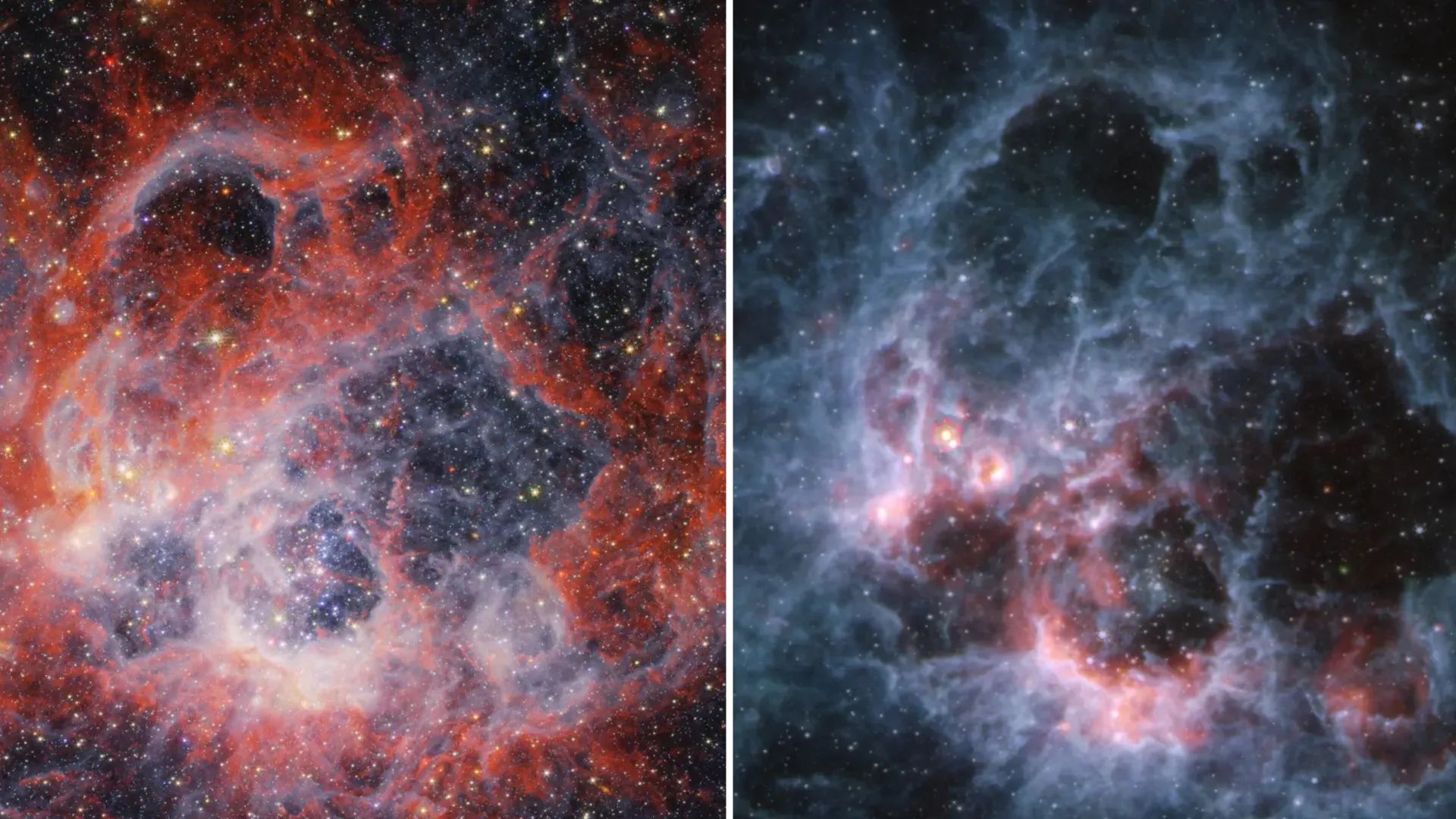
The images of NGC 604 sent by the James Webb Space Telescope.
About 1,300 light years away from Earth, there lies a massive stellar nursery named NGC 604, which is home to nearly 200 stars. Recently, NASA’s James Webb telescope captured two detailed images of this cosmic wonder, revealing many surprising details.
NGC 604 is inside Messier 33 (M33), a galaxy located within the peculiar triangle-shaped Triangulum constellation.
Compared to our Milky Way galaxy, it is 50 percent smaller in size.
However, its NGC 604 region, which appears like a bright blue patch, is one of the most massive star-forming regions.
The recent images taken by Webb’s Mid-Infrared Instrument (MIRI) and Near-infrared camera (NIRCam) reveal never-before-seen cosmic bubbles, stars, and gaseous structures branching out of NGC 604.
The underlying details in the images
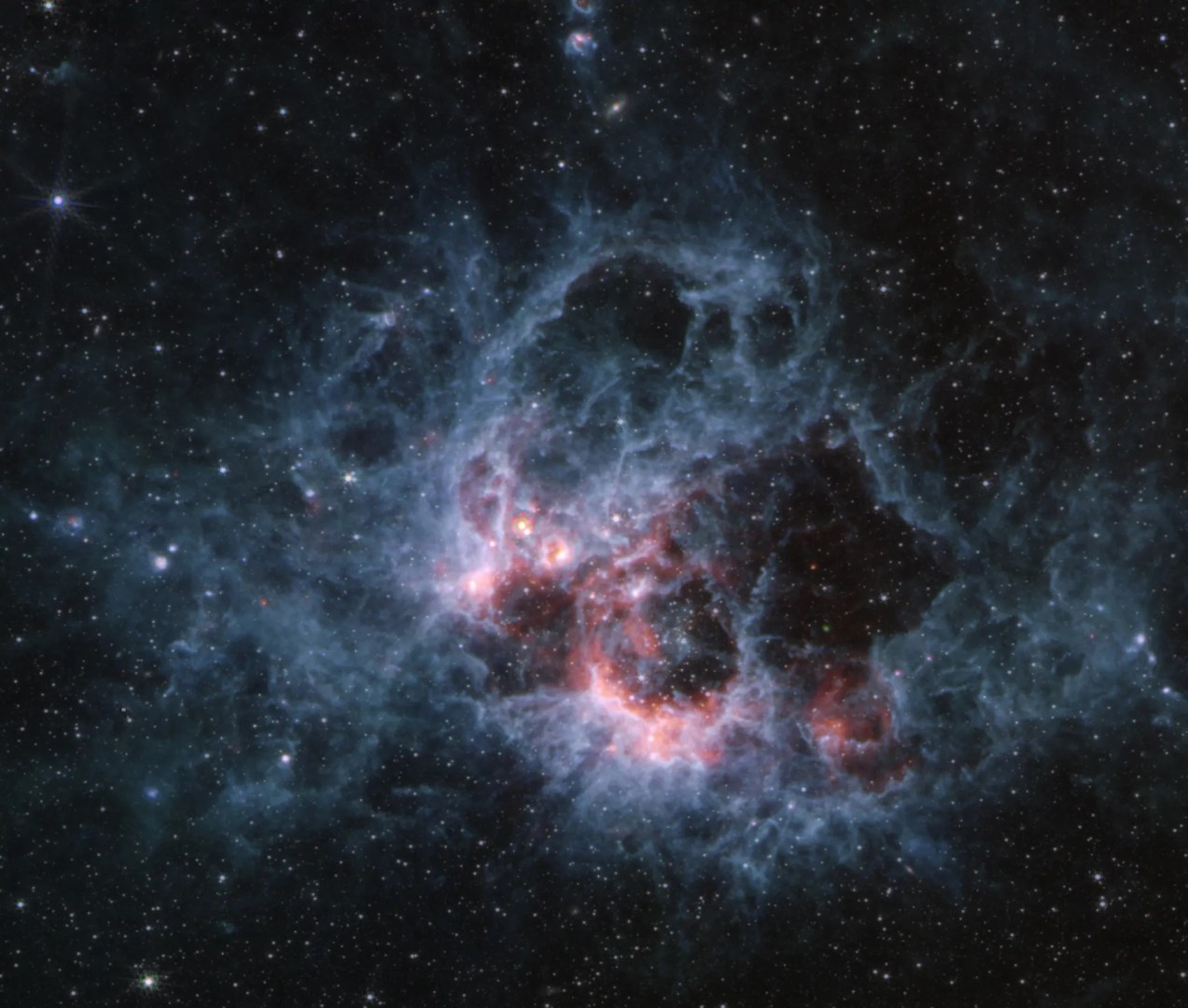
The image from the MIRI has fewer stars including some reg supergiants. The latter could be a million times brighter and a hundred times bigger than our Sun.
It also highlights blue tendril-like formations that suggest the presence of polycyclic aromatic hydrocarbons (PAH), according to NASA. PAH is an important cosmic ingredient as it plays a key role in developing planets and stars.
However, the MIRI image doesn’t reveal hot stars because it doesn’t capture the wavelength emitted by them. This is where the NIRCam image proves to be very useful.
The image captured by NIRCam confirms the presence of two young stars located above the central nebula (clouds of cosmic gas and dust). Interestingly, the Hubble Telescope previously identified these stars as irregular spots.
It also contains bright red bubble-like structures within the nebula. According to NASA, these bubbles are formed by the activity of winds originating from the hottest and brightest stars of NGC 604.
Moreover, the tendrils that appeared in the MIRI image are also actually extensions branching out from the bubbles.
Why do these details matter?

To a normal person, the images of NGC 604 may appear like a painting or an ordinary photo of cosmic clouds and stars. However, for astronomers, stellar nurseries and the details they hold are of great significance.
This is because vast star-forming regions like NGC 604 comprise a variety of organic molecules that can reveal information not just about the development of planets and stars, but also about the origin of life.
“In these cold molecular clouds, you’re creating the first building blocks that will, in the end, form stars and planets,” Jordy Bouwman, an expert on chemistry and space physics at CU Boulder, said in a press release.
Thanks to James Webb, for the first time, researchers are able to produce such high-resolution and detailed images of NGC 604.
Hopefully, the insights from these images will increase our understanding of the cosmos, and help us decode several other mysteries linked to this star nursery.
You can read the press release from NASA here.
"These special objects could change the way we think about the genesis of black holes."
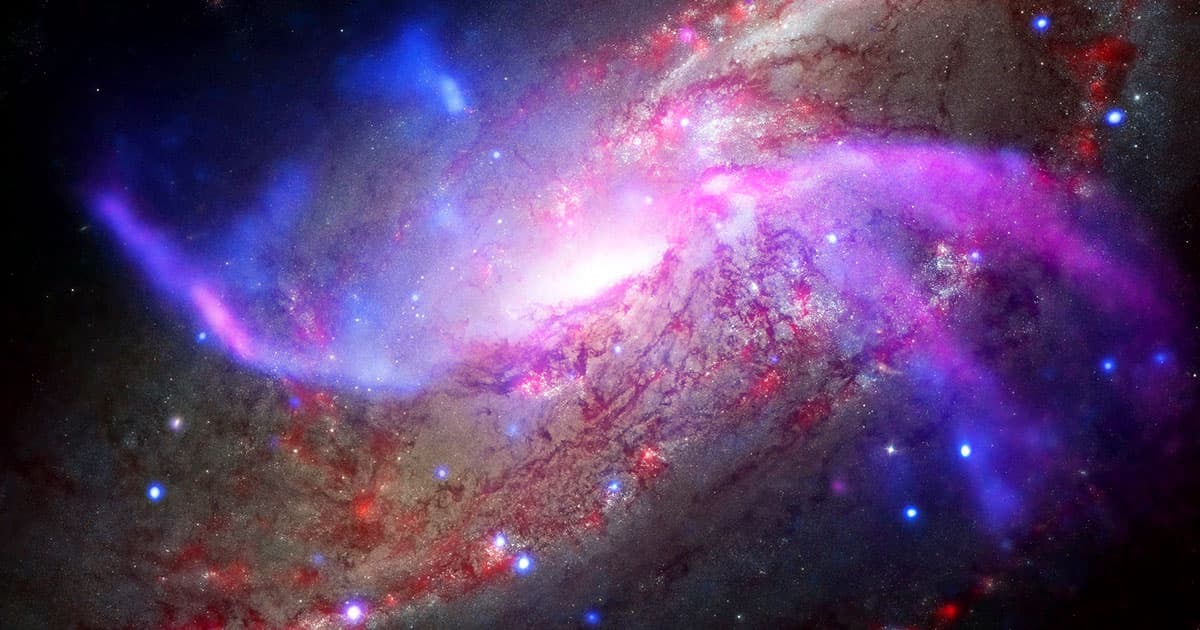
Image by Getty Images
NASA's James Webb Space Telescope has made one of its "most unexpected" discoveries to date: tiny red dots in some of the oldest corners of the universe, which turned out to be "baby" life stages of supermassive black holes.
After studying observations by the groundbreaking observatory, the team concluded that "faint little red dots very far away in the universe's distant past are small versions of extremely massive black holes," as team lead Jorryt Matthee, astrophysics assistant professor at the Institute of Science and Technology Austria and lead author of a new paper published in The Astrophysical Journal, explained in a statement.
"These special objects could change the way we think about the genesis of black holes," he added.
The team is hoping to hone in on how these early-stage supermassive black holes, which often lurk at the center of large galaxies including our own, came to be and how they change over billions of years.
"The present findings could bring us one step closer to answering one of the greatest dilemmas in astronomy: According to the current models, some supermassive black holes in the early universe have simply grown 'too fast,'" Matthee explained. "Then how did they form?"
As their name suggests, supermassive black holes can reach epic proportions, anywhere from millions to billions of times the mass of our Sun. While scientists believe they can grow by merging with other black holes, their origin remains an active field of study.
Over the last couple of years, scientists have found evidence of one hiding at the center of the Milky Way dubbed Sagittarius A*, which is roughly 4.3 million times the mass of the Sun.
Some types of supermassive black holes, called quasars, are extremely luminous galactic cores that light up as gas and dust fall into them. They're some of the brightest objects in the universe, emitting thousands of times more light than our entire galaxy.
Matthee and his colleagues believe the little red dots in the JWST images are quasars — except that they're far smaller than their counterparts elsewhere.
"One issue with quasars is that some of them seem to be overly massive, too massive given the age of the universe at which the quasars are observed," Matthee said in the statement. "If we consider that quasars originate from the explosions of massive stars and that we know their maximum growth rate from the general laws of physics, some of them look like they have grown faster than is possible."
As a result, the astrophysicist suggests the "little red dots are more like 'baby quasars,'" with masses somewhere between "ten and a hundred million solar masses." They likely predate the stage of these "problematic quasars,"as Matthee puts it, which are more massive than they should be.
As for why they're red, Matthee has a simple answer: "Because they are dusty. The dust obscures black holes and reddens the colors" in the observations.
The "baby quasars" are destined to balloon into much larger supermassive black holes, eventually turning into ones that appear blue thanks to the bright disc of matter that orbits and feeds them.
"Studying baby versions of the overly massive SMBHs in more detail will allow us to better understand how problematic quasars come to exist," Matthee concluded.
The team used datasets acquired by the EIGER (Emission-line galaxies and Intergalactic Gas in the Epoch of Reionization) experiment to come to their conclusion.
While EIGER wasn't designed to find the little red dots in particular, the team "found them by chance in the same dataset," Matthee explained.
But mysteries linger, and more research will be needed.
"So far, we have probably only scratched the surface," Matthee said.
More on supermassive black holes: James Webb Spots "Extremely Red" Black Hole
Webb’s Historic Discovery: The Farthest Active Supermassive Black Hole Ever Found
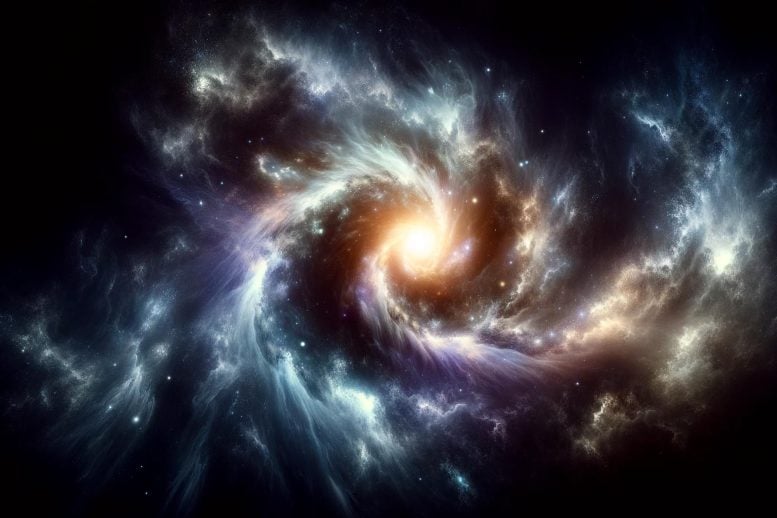
Researchers using the James Webb Space Telescope have made groundbreaking discoveries in galaxy GN-z11, which is one of the most distant and luminous galaxies known. They identified a supermassive black hole responsible for the galaxy’s brightness and found a pristine gas clump that may lead to the discovery of the universe’s first stars, providing significant insights into cosmic evolution. (Artist’s concept.) Credit: SciTechDaily.com
The enigmatic galaxy GN-z11 is one of the youngest ever observed.
Delivering on its promise to transform our understanding of the early universe, the James Webb Space Telescope is probing galaxies near the dawn of time. One of these is the exceptionally luminous galaxy GN-z11, which existed when the universe was just a tiny fraction of its current age. One of the youngest and most distant galaxies ever observed, it is also one of the most enigmatic. Why is it so bright? Webb appears to have found the answer.
Scientists using Webb to study GN-z11 have also uncovered some tantalizing evidence for the existence of Population III stars nestled in the outskirts of this remote galaxy. These elusive stars — the first to bring light to the universe — are purely made of hydrogen and helium. No definitive detection of such stars has ever been made, but scientists know they must exist. Now, with Webb, their discovery seems closer than ever before.
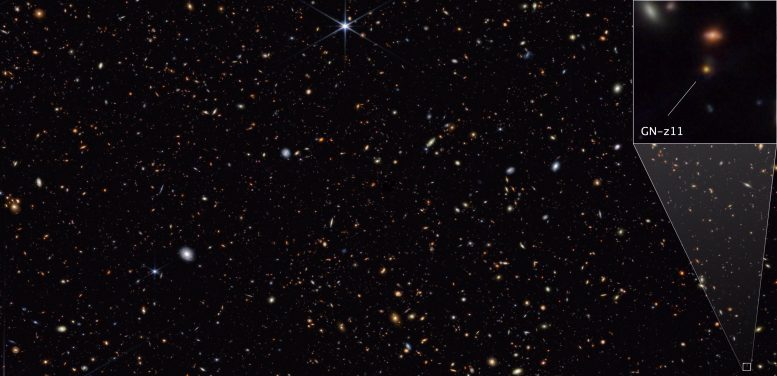
This image from Webb’s NIRCam (Near-Infrared Camera) instrument shows a portion of the GOODS-North field of galaxies. At lower right, a pullout highlights the galaxy GN-z11, which is seen at a time just 430 million years after the big bang. The image reveals an extended component, tracing the GN-z11 host galaxy, and a central source whose colors are consistent with those of an accretion disk surrounding a black hole. Credit: NASA, ESA, CSA, STScI, Brant Robertson (UC Santa Cruz), Ben Johnson (CfA), Sandro Tacchella (Cambridge), Marcia Rieke (University of Arizona), Daniel Eisenstein (CfA)
Webb Unlocks Secrets of One of the Most Distant Galaxies Ever Seen
Looking deeply into space and time, two teams using NASA’s James Webb Space Telescope have studied the exceptionally luminous galaxy GN-z11, which existed when our 13.8 billion-year-old universe was only about 430 million years old.
Initially detected with NASA’s Hubble Space Telescope, this galaxy — one of the youngest and most distant ever observed — is so bright that it is challenging scientists to understand why. Now, GN-z11 is giving up some of its secrets.
Vigorous Black Hole Is Most Distant Ever Found
A team studying GN-z11 with Webb found the first clear evidence that the galaxy is hosting a central, supermassive black hole that is rapidly accreting matter. Their finding makes this the farthest active supermassive black hole spotted to date.
“We found extremely dense gas that is common in the vicinity of supermassive black holes accreting gas,” explained principal investigator Roberto Maiolino of the Cavendish Laboratory and the Kavli Institute of Cosmology at the University of Cambridge in the United Kingdom. “These were the first clear signatures that GN-z11 is hosting a black hole that is gobbling matter.”
Using Webb, the team also found indications of ionized chemical elements typically observed near accreting supermassive black holes. Additionally, they discovered a very powerful wind being expelled by the galaxy. Such high-velocity winds are typically driven by processes associated with vigorously accreting supermassive black holes.
“Webb’s NIRCam (Near-Infrared Camera) has revealed an extended component, tracing the host galaxy, and a central, compact source whose colors are consistent with those of an accretion disk surrounding a black hole,” said investigator Hannah Übler, also of the Cavendish Laboratory and the Kavli Institute.
Together, this evidence shows that GN-z11 hosts a 2-million-solar-mass, supermassive black hole in a very active phase of consuming matter, which is why it’s so luminous.
Pristine Gas Clump in GN-z11’s Halo Intrigues Researchers
A second team, also led by Maiolino, used Webb’s NIRSpec (Near-Infrared Spectrograph) to find a gaseous clump of helium in the halo surrounding GN-z11.
“The fact that we don’t see anything else beyond helium suggests that this clump must be fairly pristine,” said Maiolino. “This is something that was expected by theory and simulations in the vicinity of particularly massive galaxies from these epochs — that there should be pockets of pristine gas surviving in the halo, and these may collapse and form Population III star clusters.”
Finding the never-before-seen Population III stars — the first generation of stars formed almost entirely from hydrogen and helium — is one of the most important goals of modern astrophysics. These stars are anticipated to be very massive, very luminous, and very hot. Their expected signature is the presence of ionized helium and the absence of chemical elements heavier than helium.
The formation of the first stars and galaxies marks a fundamental shift in cosmic history, during which the universe evolved from a dark and relatively simple state into the highly structured and complex environment we see today.
In future Webb observations, Maiolino, Übler, and their team will explore GN-z11 in greater depth, and they hope to strengthen the case for the Population III stars that may be forming in its halo.
The research on the pristine gas clump in GN-z11’s halo has been accepted for publication by Astronomy & Astrophysics. The results of the study of GN-z11’s black hole were published in the journal Nature on January 17, 2024. The data was obtained as part of the JWST Advanced Deep Extragalactic Survey (JADES), a joint project between the NIRCam and NIRSpec teams.
The James Webb Space Telescope is the world’s premier space science observatory. Webb is solving mysteries in our solar system, looking beyond to distant worlds around other stars, and probing the mysterious structures and origins of our universe and our place in it. Webb is an international program led by NASA with its partners, ESA (European Space Agency) and the Canadian Space Agency.
'Baby quasars': James Webb Space Telescope spots little giants in the deep past
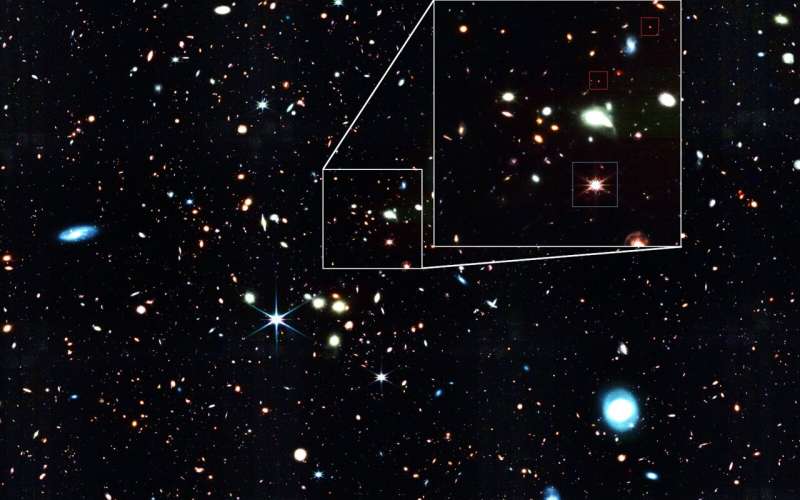
The James Webb Space Telescope has made one of the most unexpected findings within its first year of service: A high number of faint little red dots in the distant universe could change the way we understand the genesis of supermassive black holes.
The research, led by Jorryt Matthee, Assistant Professor in astrophysics at the Institute of Science and Technology Austria (ISTA), is now published in The Astrophysical Journal.
A bunch of little red dots found in a tiny region of our night sky might indeed be an unexpected breakthrough for the James Webb Space Telescope (JWST) during its first year of service. These objects were indistinguishable from normal galaxies through the "eyes" of the older Hubble Space Telescope.
"Without having been developed for this specific purpose, the JWST helped us determine that faint little red dots--found very far away in the universe's distant past--are small versions of extremely massive black holes. These special objects could change the way we think about the genesis of black holes," says Matthee, Assistant Professor at the Institute of Science and Technology Austria (ISTA), and lead author of the study.
"The present findings could bring us one step closer to answering one of the greatest dilemmas in astronomy: According to the current models, some supermassive black holes in the early universe have simply grown 'too fast.' Then how did they form?"
The cosmic points of no return
Scientists had long considered black holes a mathematical curiosity, until their existence became increasingly evident. These strange cosmic bottomless pits could have such compact masses and strong gravities that nothing can escape their force of attraction; they suck in anything, including cosmic dust, planets, and stars, and deform the space and time around them such that even light cannot escape.
The general theory of relativity, published by Albert Einstein over a century ago, predicted that black holes could have any mass. Some of the most intriguing black holes are the supermassive black holes (SMBHs), which could reach millions to billions of times the mass of the sun. Astrophysicists agree that there is an SMBH at the center of almost every large galaxy. The proof that Sagittarius A* is an SMBH in the center of our galaxy with over four million times the sun's mass, earned the 2020 Nobel Prize in Physics.
Too massive to be there
However, not all SMBHs are the same. While Sagittarius A* could be compared to a sleeping volcano, some SMBHs grow extremely rapidly by engulfing astronomic amounts of matter. Thus, they become so luminous that they can be observed until the edge of the ever-expanding universe. These SMBHs are called quasars, and are among the brightest objects in the universe.
"One issue with quasars is that some of them seem to be overly massive, too massive given the age of the universe at which the quasars are observed. We call them the 'problematic quasars,'" says Matthee.
"If we consider that quasars originate from the explosions of massive stars–and that we know their maximum growth rate from the general laws of physics, some of them look like they have grown faster than is possible. It's like looking at a five-year-old child that is two meters tall. Something doesn't add up," he explains.
Could SMBHs perhaps grow even faster than we originally thought? Or do they form differently?
Small versions of giant cosmic monsters
Now, Matthee and his colleagues identify a population of objects that appear as little red dots in JWST images. Also, they demonstrate that these objects are SMBHs, but not overly massive ones.
Central in determining that these objects are SMBHs was the detection of Hα spectral emission lines with wide line profiles. Hα lines are spectral lines in the deep-red region of visible light that are emitted when hydrogen atoms are heated. The width of the spectra traces the motion of the gas.
"The wider the base of the Hα lines, the higher the gas velocity. Thus, these spectra tell us that we are looking at a very small gas cloud that moves extremely rapidly and orbits something very massive like an SMBH," says Matthee.
However, the little red dots are not the giant cosmic monsters found in overly massive SMBHs.
"While the 'problematic quasars' are blue, extremely bright, and reach billions of times the mass of the sun, the little red dots are more like 'baby quasars.' Their masses lie between ten and a hundred million solar masses. Also, they appear red because they are dusty. The dust obscures the black holes and reddens the colors," says Matthee.
But eventually, the outflow of gas from the black holes will puncture the dust cocoon, and giants will evolve from these little red dots. Thus, the ISTA astrophysicist and his team suggest that the little red dots are small, red versions of giant blue SMBHs in the phase that predates the problematic quasars.
"Studying baby versions of the overly massive SMBHs in more detail will allow us to better understand how problematic quasars come to exist," Matthee explains.
A 'breakthrough' technology
Matthee and his team were able to find the baby quasars thanks to the datasets acquired by the EIGER (Emission-line galaxies and Intergalactic Gas in the Epoch of Reionization) and FRESCO (First Reionization Epoch Spectroscopically Complete Observations) collaborations. These are a large and a medium JWST program in which Matthee was involved. Last December, Physics World magazine listed EIGER among the top 10 breakthroughs of the year for 2023.
"EIGER was designed to study specifically the rare blue supermassive quasars and their environments. It was not designed to find the little red dots. But we found them by chance in the same dataset. This is because by using the JWST's Near Infrared Camera, EIGER acquires emission spectra of all objects in the universe," says Matthee. "If you raise your index finger and extend your arm completely, the region of the night sky we explored corresponds to roughly a twentieth of the surface of your nail. So far, we have probably only scratched the surface."
Matthee is confident that the present study will open up many avenues and help answer some of the big questions about the universe.
"Black holes and SMBHs are possibly the most interesting things in the universe. It's hard to explain why they are there, but they are there. We hope that this work will help us lift one of the biggest veils of mystery about the universe," he concludes.
More information: Little Red Dots: An Abundant Population of Faint Active Galactic Nuclei (AGN) at z ~ 5 Revealed by the EIGER and FRESCO JWST Surveys, The Astrophysical Journal (2024). DOI: 10.3847/1538-4357/ad234
Journal information: Astrophysical Journal , Physics World
Provided by Institute of Science and Technology Austria Webb sees dozens of young quasars in the first billion years of the universe
James Webb telescope detects oldest 'dead' galaxy in the known universe — and its death could challenge cosmology
By Sharmila Kuthunur published 5 days ago
Astronomers using the James Webb Space Telescope have detected the oldest "dead" galaxy ever observed, at just 700 million years after the Big Bang. The stalled-out relic defies explanation by our current knowledge of the early cosmos.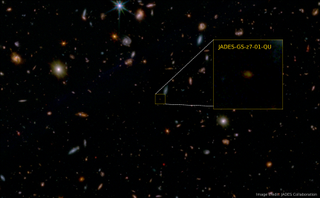
Astronomers using the James Webb Space Telescope (JWST) have discovered the oldest "dead" galaxy ever seen — but the cosmic corpse has left scientists puzzled as it defies explanation by our current knowledge of the early cosmos.
The galaxy suddenly and mysteriously halted star formation when the universe was just 700 million years old, when countless stars were birthing thanks to an abundance of pristine gas and dust elsewhere in the universe.
The galaxy, named JADES-GS-z7-01-QU and described in a paper published Wednesday (March 6) in the journal Nature, provides astronomers with a peek into the elusive underpinnings of galaxy evolution in a primordial universe, including why galaxies stop forming new stars and whether forces driving their starbursts alter across epochs.
"Galaxies need a rich supply of gas to form new stars, and the early universe was like an all-you-can-eat buffet," study lead author Tobias Looser, a researcher at the University of Cambridge's Kavli Institute for Cosmology, Cambridge (KICC), said in a statement.
Related: 'Mind-blowing' James Webb telescope images reveal 19 spiral galaxies in the greatest detail ever seen
Current models cannot explain how the newfound galaxy not only took shape in less than a billion years after the Big Bang, but also shut down its star factory so quickly. "It's only later in the universe that we [usually] start to see galaxies stop forming stars," study co-author Francesco D'Eugenio, also a researcher at KICC, said in the statement. In comparison, a handful of other "dead" galaxies found elsewhere appear to have paused forming new stars when the universe was about 3 billion years old, the researchers said.
"Everything seems to happen faster and more dramatically in the early universe," added Looser. "And that might include galaxies moving from a star-forming phase to dormant or quenched."
To discover JADES-GS-z7-01-QU, Looser and his colleagues used the JWST's powerful infrared vision to peer through the thick veil of dust obscuring the earliest objects in the universe. In addition to being the oldest "dead" or "quenched" galaxy spotted so far, the newfound galaxy is also many times lighter than other similarly quiescent galaxies previously found in the early universe.
JWST's data suggest the galaxy intensely formed stars for somewhere between 30 million to 90 million years before it rapidly shut off, although precisely what ended it is still unknown. Astronomers know of a couple different factors that can slow down or extinguish star formation. For instance, turbulence inside a galaxy, such as radiation emitted by a supermassive black hole, can push gas out of the galaxy and starve it of the gas reservoir it relies on to form stars. Another intriguing possibility is that the galaxy's surroundings at the time did not sufficiently replenish the gas reservoir being consumed by birthing stars, leading to a deficit in star-forming material.
However, "we're not sure if any of those scenarios can explain what we've now seen with Webb," study co-author Roberto Maiolino, an astrophysicist at KICC, said in the statement. Current models based on the modern universe are unable to explain the properties of JADES-GS-z7-01-QU, suggesting they "may need to be revisited," Maiolino said.
Another possible explanation for the new galaxy's dormancy could be that "galaxies in the early universe 'die' and then burst back to life," D'Eugenio said. However, previous research of "dead" galaxies from when the universe was around 3 billion years old — a time of its most prolific star birth — suggested such "dead" galaxies cannot rejuvenate even via mergers with nearby galaxies, which instead only serve to "puff" them up.
"We'll need more observations to help us figure that out," said D'Eugenio.
By Ashley Strickland, CNN
Wed March 6, 2024
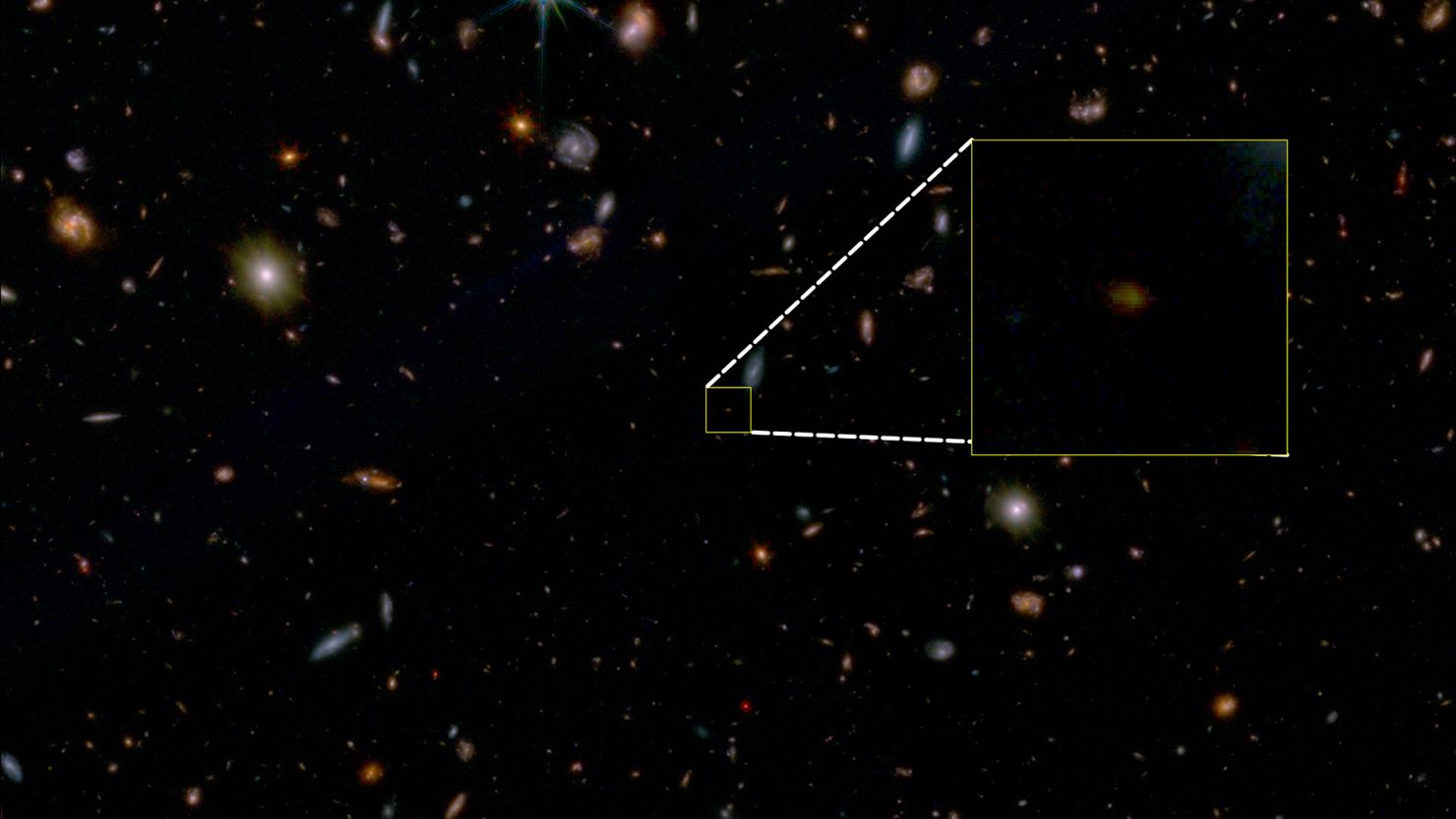
A new image taken by the James Webb Space Telescope reveals a "dead" galaxy, named JADES-GS-z7-01-QU, in the distant universe. JADES Collaboration
Astronomers have spotted the oldest “dead” galaxy ever observed while studying the cosmos with the James Webb Space Telescope, and it’s one of the deepest views into the distant universe made with the observatory to date.
The galaxy existed when the universe was only about 700 million years into its current age of about 13.8 billion years. But something made the galaxy suddenly halt star formation almost as quickly as star birth had begun more than 13 billion years ago, and the researchers have yet to uncover the cause.
A report describing the discovery appeared Wednesday in the journal Nature. Studying the galaxy could reveal new insights about the early universe and the factors that affect star formation within galaxies, according to the authors.
“The first few hundred million years of the universe was a very active phase, with lots of gas clouds collapsing to form new stars,” said lead study author Tobias Looser, doctoral student in extragalactic astrophysics at the University of Cambridge’s Kavli Institute for Cosmology, in a statement. “Galaxies need a rich supply of gas to form new stars, and the early universe was like an all-you-can-eat buffet.”

‘Mind-blowing’ new images reveal 19 galaxies ‘down to the smallest scales ever observed’
The research team was surprised to find a so-called dead galaxy that essentially lived fast and died young so soon after the big bang that created the universe.
“It’s (usually) only later in the universe that we start to see galaxies stop forming stars, whether that’s due to a black hole or something else,” said study coauthor Dr. Francesco D’Eugenio, astrophysicist and postdoctoral research associate at the Kavli Institute for Cosmology, in a statement.
What causes galaxies to die
Star formation ceases when environmental factors starve a galaxy of the gas needed to seed the birth of new stars.
Supermassive black holes or the violent interactions of stars can be the culprits that eject gas from galaxies, bringing star formation to a quick halt. Or, the act of star birth can consume so much gas that there isn’t time for enough to be replenished to ensure the process will continue in the future.
“We’re not sure if any of those scenarios can explain what we’ve now seen with Webb,” said study coauthor Roberto Maiolino, professor of experimental astrophysics at the Cavendish Laboratory and the Kavli Institute for Cosmology at the University of Cambridge, in a statement.
“Until now, to understand the early universe, we’ve used models based on the modern universe. But now that we can see so much further back in time, and observe that the star formation was quenched so rapidly in this galaxy, models based on the modern universe may need to be revisited,” Maiolino added.
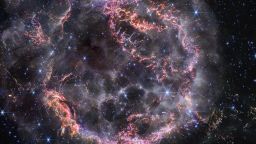
Scientists discover ‘staggering’ features in massive Milky Way star explosion
The Webb observations revealed that the newly discovered galaxy, named JADES-GS-z7-01-QU, experienced a short, energetic burst of star formation that lasted between 30 million and 90 million years before star birth suddenly stopped.
“Everything seems to happen faster and more dramatically in the early universe, and that might include galaxies moving from a star-forming phase to dormant or quenched,” Looser said.
An unusual observation
The dead galaxy revealed by the study is not the first astronomers have come across, but it is the oldest one observed thus far.
What’s more, the galaxy also had a low mass, similar to a dwarf galaxy near the Milky Way known as the Small Magellanic Cloud — which is still forming new stars. Previously observed dead galaxies have been much larger, adding another quirk to the Webb discovery.
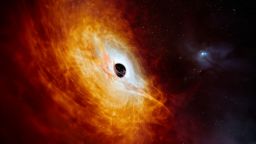
Brightest known object in the universe was hiding in plain sight for decades, researchers say
The newly found galaxy is billions of light-years away from Earth, and a light-year is how far a beam of light travels in a year, or over 5.88 trillion miles (9.46 trillion kilometers). So Webb is essentially observing the galaxy as it existed in the past — and astronomers have not ruled out the possibility that it may have essentially resurrected and begun star formation anew.
“We’re looking for other galaxies like this one in the early universe, which will help us place some constraints on how and why galaxies stop forming new stars,” D’Eugenio said. “It could be the case that galaxies in the early universe ‘die’ and then burst back to life — we’ll need more observations to help us figure that out.”
No comments:
Post a Comment